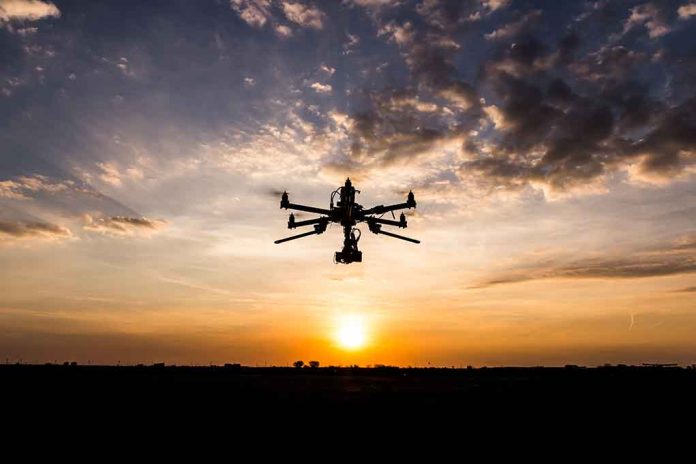
Russian official Sergei Tokarev accidentally shot himself in the head while panicking during a Ukrainian drone attack on Crimea, highlighting the escalating drone warfare that continues to cripple Russian military infrastructure and civilian air travel.
Key Takeaways
- Sergei Tokarev, head of the military medical commission in Sevastopol, died after accidentally shooting himself during a Ukrainian drone barrage on Crimea.
- Ukraine launched a massive drone attack targeting multiple Russian military facilities in occupied Crimea, with Russia claiming to have intercepted over 89 drones.
- Explosions were reported at strategic Russian airfields including Sevastopol, Dzhankoy, Saky, Novofedorivka, and Kacha, despite Russian denials of damage.
- The drone campaign has disrupted Russian civilian air travel, with at least 60,000 passengers stranded and 350 flights affected across major cities.
- Russia’s proposed three-day ceasefire was rejected by Ukraine, while the US and allies continue to push for dialogue between the warring nations.
Bizarre Death Highlights Impact of Drone Warfare
In a remarkable demonstration of the psychological impact of Ukraine’s drone campaign, a high-ranking Russian official in occupied Crimea fatally shot himself while responding to an air raid. Sergei Tokarev, who headed the military medical commission of Sevastopol’s Ministry of Internal Affairs, panicked during a Ukrainian drone barrage, armed himself with a pistol, and accidentally discharged the weapon into his own head. The incident occurred amid a massive coordinated attack that targeted multiple strategic locations across the Russian-occupied peninsula.
The Astra Telegram channel reported: “The head of the military medical commission of Sevastopol’s Ministry of Internal Affairs died after accidentally shooting himself in the head during a massive drone attack.”
Kyiv-based journalist Dennis Kazansky commented on the unusual death, stating: “This is the most unexpected effect of a drone I have ever heard about.” The incident reflects the growing tension among Russian officials in Crimea as Ukrainian forces continue their technological assault on the illegally annexed territory. Despite Moscow’s repeated claims of successfully intercepting most incoming drones, evidence suggests Ukraine’s campaign is effectively disrupting Russian military capabilities in the region.
Widespread Attacks on Strategic Military Installations
Ukraine’s recent drone offensive targeted critical Russian military infrastructure across Crimea. Multiple explosions were reported near airfields at Saky, Kacha, Hvardiiske, and Dzhankoi, with possible secondary strikes near Belbek. These installations serve as crucial bases for Russia’s Black Sea Fleet operations and launching platforms for attacks against Ukrainian territory. Videos circulating on social media showed significant explosions and fires near the village of Uhlove, close to the strategically important Kacha airfield.
“The fleet, in cooperation with air defense forces, is reflecting a massive combined attack,” admitted Mikhail Razvozhayev, the Russian-installed leader in Sevastopol, although he claimed no infrastructure damage had occurred.
While Russia’s defense ministry claimed to have shot down 524 Ukrainian drones in a 24-hour period, independent verification of these numbers remains challenging. However, the frequency and scale of Ukrainian drone operations suggest a coordinated strategy to systematically degrade Russian military capabilities in Crimea, particularly targeting air assets that provide Moscow with a tactical advantage in the Black Sea region.
Civilian Impact and International Tensions
The drone campaign has extended beyond military targets, disrupting Russia’s civilian infrastructure. At least 60,000 passengers were reportedly stranded at Russian airports due to Ukrainian drone attacks, with approximately 350 flights affected in Moscow, St. Petersburg, Sochi, and other major cities. These disruptions coincided with preparations for Russia’s World War II victory parade, where President Putin hosted 27 world leaders, including Chinese President Xi Jinping.
“We think they [Russians] are asking for too much,” stated US Vice-President JD Vance regarding Russia’s proposed three-day ceasefire ahead of the military parade. “It’s very important for the Russians and the Ukrainians to start talking to one another.”
President Trump’s administration continues to push both nations toward diplomatic solutions while acknowledging the complexity of the situation. Vance emphasized: “We would like both the Russians and the Ukrainians to actually agree on some basic guidelines for sitting down and talking to one another.” Meanwhile, Ukraine and its allies have called for an unconditional 30-day ceasefire, highlighting the significant gap between the warring parties’ positions.
Future Implications of Escalating Drone Warfare
Military analysts expect Ukraine to continue its drone campaign against Russian targets, particularly as conventional battlefield advantages remain elusive. The psychological impact of constant aerial threats, exemplified by Tokarev’s accidental death, may prove as strategically valuable as the physical damage to military infrastructure. Russia’s need to divert significant resources to air defense systems throughout occupied territories strains their operational capabilities on the front lines.
The Baltic states have intensified pressure on Russia by refusing airspace access for certain flights to Moscow, further isolating Putin’s regime internationally. As Ukraine demonstrates increasing sophistication in its drone operations, the security situation in Crimea, which Russia illegally annexed in 2014, continues to deteriorate despite Moscow’s claims of territorial control. The ongoing strikes represent Ukraine’s determination to reclaim its sovereign territory through asymmetric warfare tactics that exploit Russia’s vulnerabilities.







